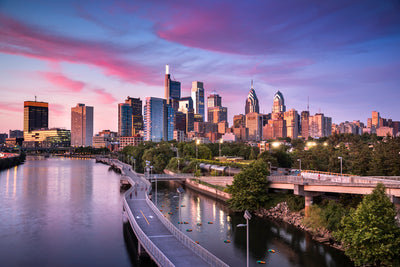Problems We Found With Philadelphia Drinking Water
RSS
Kezia Snipe | Research Analyst
**Updated 4/3/2023**
Philadelphia’s drinking water comes entirely from surface water, coming from the Delaware River Watershed, which begins in New York State and extends 330 miles south to the mouth of the Delaware Bay and includes the Delaware and Schuylkill Rivers. The Philadelphia Water Department supplies an average of 300 million gallons of drinking water to each day. Hydroviv’s Science Team has aggregated water quality test data from the Philadelphia Water Department, the U.S. Environmental Protection Agency (EPA), the Environmental Working Group (EWG), and the US Geological Survey. The custom water filters that we build for our customers in Philadelphia are optimized with this research in mind.
Chemical Spill Update
- On Friday, March 24, 2023, a synthetic latex product spilled from a chemical plant along a tributary of the Delaware River, 13 miles north of the Baxter Drinking Water Treatment Plant, one of three main water treatment facilities that provide water to Philadelphia residents.
- The primary substances that were tested for were butyl acrylate, ethyl acrylate, and methyl methacrylate.
- In response, Philadelphia Water shut intakes to the Baxter Drinking Water Treatment plant as a precaution and instituted a monitoring plan to determine whether any contaminated water entered the Baxter Drinking Water Treatment Plant.
- After around-the-clock monitoring, as of March 28, 2023, the Philadelphia Water Department declared Philadelphia’s drinking water is safe to drink and use, and that Philadelphia’s drinking water will not be impacted by the chemical spill.
- Additional explanation regarding what happened can be found in this video from Dr. Eric Roy, Hydroviv's Founder and Chief Scientist.
What are concerns in Philadelphia’s Drinking Water?
Contaminants of concern in the Philadelphia drinking water include Lead, Chromium 6, PFAS, and Disinfection Byproducts.
Lead In Philadelphia’s Drinking Water
Recent estimates indicate that Philadelphia has over 20,000 homes with lead service pipes. Lead comes from the plumbing, not the water supply. Currently 10% of Philadelphia's water quality samples collected for lead analysis are reported to be 3 parts per billion or higher, but the risk of lead in drinking water is much higher than that number suggests. The EPA, CDC and the American Academy of Pediatrics all recognize that there is no safe level of lead for children. We recommend using a filter for drinking water that is certified for lead removal, especially if you are living in a home built before 1986. In addition, the Philadelphia Water Department will conduct free lead tests for residential customers. Call 215-685-6300 to schedule an appointment.
Chromium 6 Contamination In Philadelphia Drinking Water
Chromium 6 is a highly toxic metal that is not regulated by the EPA. According to testing conducted by the Environmental Working Group, Philadelphia was measured to have Chromium 6 levels ranging between 0.22 - 0.75 ppb (220 - 750 ppt), with an average Chromium 6 level of 0.39 ppb (390 ppt) which are are from 11 - 37.5 times higher than the level generally accepted as safe. The California EPA has acknowledged that ingesting Chromium 6 through drinking water can increase the risk of stomach cancer and reproductive issues.
PFAS in Philadelphia’s Drinking Water
Per and Polyfluoroalkyl Substances (PFAS) are a category of emerging contaminants commonly used in firefighting foam, Teflon, non-stick surfaces, stain-resistant surfaces, and food packaging. The Agency for Toxic Substances and Disease Registry (ATSDR) has determined that PFAS exposure is associated with various adverse health effects, including an increased risk of cancer, lowered fertility rates, and developmental issues in infants and young children.
While Philadelphia did not report testing for PFAS chemicals, EWG reported PFAS levels as high as 1080 ppt in the groundwater of nearby military bases, and 190 ppt in the drinking water of a neighboring water system. There is no current “allowable level” in drinking water, but health agencies believe that anything above 70 ppt is considered unsafe. Not all water filters are designed to remove PFAS from tap water. If you'd like to find water filters that remove PFAS from tap water, check out this Duke/NC State PFAS study. Hydroviv filters are NSF/ANSI Standard 53 certified for PFOA/PFOS removal.
Disinfection Byproducts (DBPs) In Philadelphia Drinking Water
DBPs are a category of emerging contaminants that form when chlorine-based disinfectants react with naturally-occurring organic matter. EPA regulates two categories of DBPs: Total Trihalomethanes (TTHMs) and Haloacetic Acids (HAA5). The EPA has stated that DBPs have been associated with increased risk of bladder cancer as well as kidney, liver, and central nervous system problems. In 2021, Haloacetic Acid levels measured as high as 88 parts per billion (ppb), exceeding the EPA Maximum Contaminant Level (MCL) of 60 ppb. Total Trihalomethane levels measured as high as 101 ppb, which also exceeds the EPA MCL of 80 ppb.
How Can Hydroviv Help Me?
Hydroviv is a water filtration company that uses water quality data to optimize water filters for each customer's water. The contaminants that we list above are what we consider to be major “points of emphasis” that we use to build water filters that are built specifically for Philadelphia water, but all of our filters also include broad protection against a wide range of contaminants. Questions? Email hello@hydroviv.com.
Hydroviv's drinking water filters carry NSF certifications to Standard 42 (aesthetic effects--Chlorine Removal) and Standard 53 (health effects--Lead, VOCs, and PFOA/PFOS removal), and are independently tested to remove hundreds of contaminants.
Recommended For You:
The American Jobs Plan To Allocate $111 Billion To Water Infrastructure Improvements
How Do I Filter Chromium 6 From Drinking Water?
How Do I Tell If My Home Has Lead Pipes/Plumbing?
For updates on breaking news stories affecting drinking water, please check out our Instagram or TikTok accounts on Social Media.




